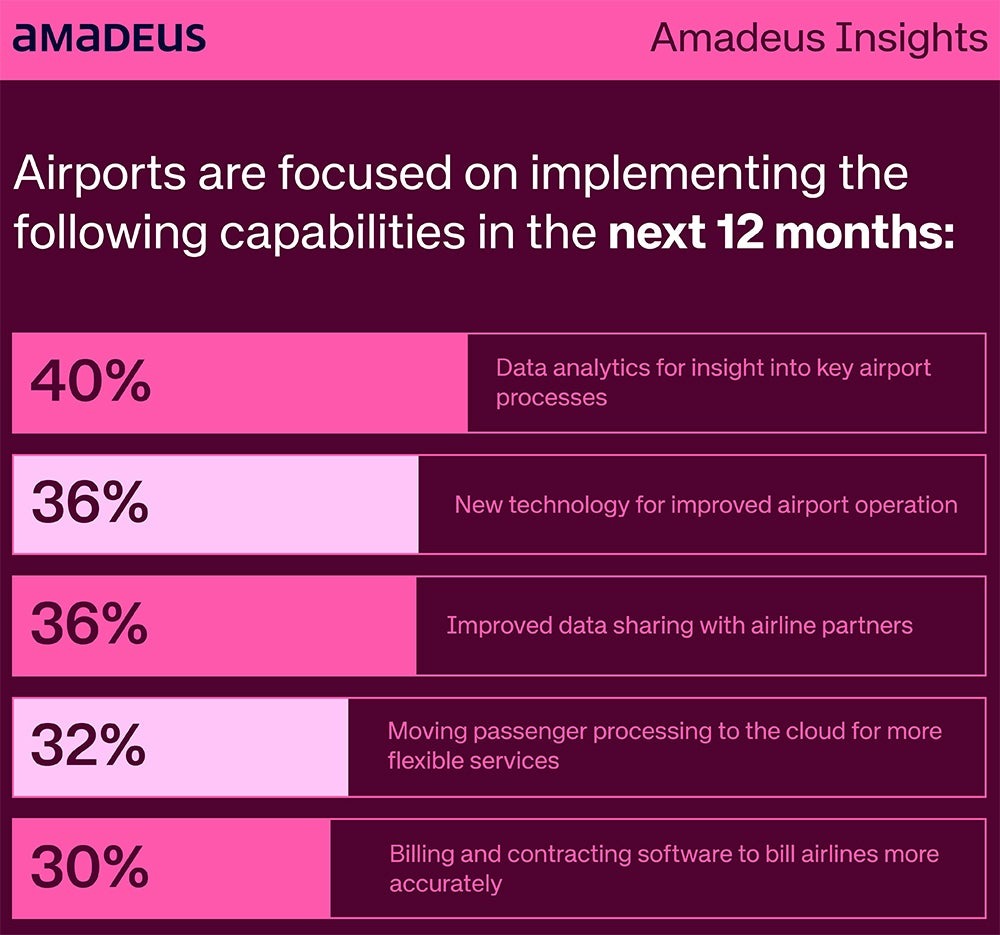Comment
Airports are becoming insight-driven
Abhishek Krishna, head of data, AI and platform – product management, airport, and airline operations at Amadeus, explains the findings of the company's recent report.

The air travel industry is undergoing a significant shift, driven by the increasing demand for a seamless and efficient travel experience. A collaborative approach, fostering cooperation among stakeholders, is essential to delivering comprehensive operating models that ultimately benefit the traveller.
The findings of Amadeus’ recent Travel Technology Investment Trends study indicate that airport leaders recognise the pivotal role of technology in facilitating collaboration. The industry is already taking steps toward realising this collaborative future through enhanced information sharing between airlines and airports and the implementation of new platform technologies at Airport Operational Control Centers.

Abhishek Krishna, head of data, AI and platform – product management, airport, and airline operations, Amadeus
There is a growing trend of airports, airlines, technology providers, and border forces working together to create a more connected and efficient travel experience. This collaborative approach is essential for the successful integration and implementation of emerging technologies, such as artificial intelligence and biometrics, which are shaping the future of airports.
By working together, stakeholders can leverage these cutting-edge solutions to streamline operations, enhance security, and elevate the overall travel experience for passengers worldwide.
Attitudes to data sharing are changing
Data sharing and analytics are essential for airports to streamline operations and deliver a seamless travel experience. Yet until recently there have been relatively few examples of such collaboration between airlines and airports. Concerns over who ‘owns’ the passenger have hampered innovation.
Our study found that attitudes are changing, with 36% of airports planning to implement improved data sharing with airline partners within the next 12 months – a positive step, but there is still room for improvement here.
At the airport, effective data sharing enables a common operational picture, which benefits both airports and airlines. It also allows for informed decision-making that ultimately benefits passengers. For example, data sharing enables airports and airlines to optimise gate allocation and reduce connection times. It also means airports can be better prepared by allocating resources more effectively and staffing in a way that best meets demand.
Of course, information alone isn’t actually that useful, it’s when analytics are performed on a reliable data set that benefits emerge. The report indicates that 40% of airports intend to implement data analytics within the next year, the ‘most implemented’ of any technology covered by the survey.
This is an encouraging development, as data-driven insights can transform airport operations. By leveraging analytics, airports can move beyond reactive troubleshooting to proactive issue resolution, predictive maintenance, and demand forecasting. The ability to anticipate baggage hotspots, passenger experience pain points, resource requirements, and even new route opportunities for their airline partners demonstrates the transformative power of analytics in driving operational efficiency and passenger satisfaction.
As airports seek to become more agile and responsive, establishing robust data capabilities is becoming a top priority. By leveraging the power of data sharing and analytics airports can better collaborate with stakeholders and achieve operational excellence.
Data analytics at the Operational Control Centre
Perhaps the biggest opportunity is at the Operational Control Centre. These centres manage the airport’s forward-rolling operational plan and stay in close communication with airlines and a wide range of service providers to ensure the plan is optimally delivered. Yet today, even these teams aren’t fully empowered by data.
Take the example of bad weather. Airports do have an understanding of approaching snow through their weather systems, but this information doesn’t get to all the stakeholders that need it quickly enough.
Typically, the key information doesn’t make it to the de-icing team until three or perhaps four hours before the snow arrives. What’s needed is a minute-by-minute weather feed that informs hourly and daily forecasts for the next five or so days. Such a system could easily alert airports of impending snow with 24 hours’ notice rather than just a few.
When that alert arrives the Airport Operations Manager could then immediately share this information with all stakeholders: airlines, ground teams and winter operations. In this scenario, everyone could prepare and use the full 24-hour window.

Ultimately, the key is understanding the impact on airport capacity and a common data view can help here too. A narrowbody aircraft is quicker to de-ice than a wide-body. With the knowledge that 10 narrow and 6 wide aircraft will need to be de-iced, the Operations Manager understands the impact on airport capacity and eventually the impact on aircraft turnarounds.
This means they can work with airline service managers to cancel the optimum number of flights much earlier, potentially before passengers even travel to the airport. Airlines can then send a communication offering alternative options that passengers can choose with a few clicks and everyone in the aviation chain benefits. For example, this would improve the passenger experience, reduce compensation costs and ensure the airport operates optimally.
There are many such scenarios where improved data sharing and the power of analytics can support better airport operations. For example, when disruption happens an airport may need to receive unexpected flights from a neighbouring hub.
In this scenario, a clear view of those arriving flights, their load factor and any special requirements is hugely valuable. If a flight is carrying a disabled passenger, then a wheelchair should be ready at the gate to avoid delays. But airports typically don’t have this picture and the wheelchair is unlikely to be in the right place, at the right time.
Where next?
The aviation industry is at a pivotal moment where collaboration among stakeholders is essential to delivering exceptional passenger experiences. By embracing data sharing and advanced analytics airports and airlines can achieve new levels of operational efficiency and traveller satisfaction.
As the industry continues to invest in these transformative solutions, it is imperative that stakeholders work in unison, breaking down silos and fostering a culture of cooperation.
Only through this collaborative approach can the full potential of these technologies be realised, paving the way for a future where air travel operations and services are optimized for the benefit of all players.
It’s time to recognize that airport processes are shared amongst multiple stakeholders and the only way to best co-ordinate them is through a common view that harnesses the latest analytics and machine learning capabilities.